Yellow dye
A randomized double-blind placebo study in 1994 revealed everything I was searching for in 2023.
Had the institutions made evidence-informed decisions like they claimed, and prioritized children's health instead of corporate profits, maybe the 1994 Rowe study would have made the changes to the food dye regulations.
Instead, anxiety and depression is on an 80 year upswing:
And behavioural problems have become a global epidemic.
Rowe (1994)
Synthetic food coloring and behavior: A·
dose response effect in a double-blind,
placebo-controlled, repeated-measures
study
The younger children (2-6 yrs) had constant crying, tantrums, irritability, restlessness, and severe sleep disturbance, and were described as "disruptive," "easily distracted and excited," "high as a kite," and "out of control." Their parents were exhausted through lack of sleep and the constant demands of their children, who were unable to be comforted or controlled. The older children were described as "irritable," "aimlessly active," "lacking self-control," "whiney and unhappy," and "like a bear with a sore head"; sleep difficulties were less likely to disturb the entire family. The sample size, compared with the number of items, precluded meaningful analysis of the behavioral I differences between reactors in the two age groups in this I study. Many parents claimed that it had taken upwards 2 years after their child commenced the diet before they actually liked him [her] again.
The younger children (2-6 yrs) had constant crying, tantrums, irritability, restlessness, and severe sleep disturbance, and were described as "disruptive," "easily distracted and excited," "high as a kite," and "out of control." Their parents were exhausted through lack of sleep and the constant demands of their children, who were unable to be comforted or controlled. The older children were described as "irritable," "aimlessly active," "lacking self-control," "whiney and unhappy," and "like a bear with a sore head"; sleep difficulties were less likely to disturb the entire family. The sample size, compared with the number of items, precluded meaningful analysis of the behavioral I differences between reactors in the two age groups in this I study. Many parents claimed that it had taken upwards 2 years after their child commenced the diet before they actually liked him [her] again.
This study demonstrated a functional relation between
the ingestion of a synthetic food color (tartrazine - yellow) and behavioral change in 24 atopic children, aged 2 to 14 years,
with marked reactions being observed at all six dosage levels of dye challenge. Even though tartrazine has been implicated as a precipitating agent in asthma, eczema, uticaria, angioedema, and migraine, the behavioral
changes observed in this study wore independent of such manifestations. Beyond 10 mg there was a ceiling effect;'
higher doses increased the duration of effect beyond 24
hours, suggesting a dose-related response.
I suspect our monkey brains see all the 0s on the nutritional information and equate that to health somehow.
Ingredients. Water, Citric Acid, Sodium Citrate, Gum Arabic, Sucralose (Sweetener), Contains Less than 2% of Natural Flavor, Sucrose Acetate Isobutyrate, Yellow 5, Sodium Benzoate and Potassium Sorbate (Preservatives).
"They were irritable and restless and had sleep disturbance. Significant reactions were observed at all six dose levels. A dose response effect was obtained. With a dose increase greater than 10 mg, the duration of effect was prolonged."
Yellow 5 (tartrazine) has been proven to cause anxiety, depression and anti-social behaviour in rats:
The Potential Health Hazard of Tartrazine and Levels of Hyperactivity, Anxiety-Like Symptoms, Depression
and Anti-social behaviour in Rats
Mervat M. Kamel*
, Heba S. El-lethey (2011)
Medicine and dental products are no place for artificial colour: sigh my petition!






Comments